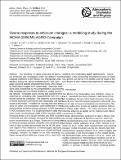Ozone response to emission changes: a modeling study during the MCMA-2006/MILAGRO Campaign
Author(s)
Lei, Wenfang; Bei, Naifang; Zavala, M.; de Foy, B.; Cardenas, B.; Zheng, J.; Zhang, R.; Molina, Luisa Tan; Song, J.; Volkamer, R. A.; ... Show more Show less
DownloadSong-2010-Ozone response to emission changes a modeling study.pdf (4.616Mb)
PUBLISHER_CC
Publisher with Creative Commons License
Creative Commons Attribution
Terms of use
Metadata
Show full item recordAbstract
The sensitivity of ozone production to precursor emissions was investigated under five different meteorological conditions in the Mexico City Metropolitan Area (MCMA) during the MCMA-2006/MILAGRO field campaign using the gridded photochemical model CAMx driven by observation-nudged WRF meteorology. Precursor emissions were constrained by the comprehensive data from the field campaign and the routine ambient air quality monitoring network. Simulated plume mixing and transport were examined by comparing with measurements from the G-1 aircraft during the campaign. The observed concentrations of ozone precursors and ozone were reasonably well reproduced by the model. The effects of reducing precursor emissions on urban ozone production were performed for three representative emission control scenarios. A 50% reduction in VOC emissions led to 7 to 22 ppb decrease in daily maximum ozone concentrations, while a 50% reduction in NOx [NO subscript x] emissions leads to 4 to 21 ppb increase, and 50% reductions in both NOx [NO subscript x] and VOC emission decrease the daily maximum ozone concentrations up to 10 ppb. These results along with a chemical indicator analysis using the chemical production ratios of H2O2 [H subscript 2 O subscript 2] to HNO3 [HNO subscript 3] demonstrate that the MCMA urban core region is VOC-limited for all meteorological episodes, which is consistent with the results from MCMA-2003 field campaign; however the degree of the VOC-sensitivity is higher during MCMA-2006 due to lower VOCs, lower VOC reactivity and moderately higher NOx [NO subscript x] emissions. Ozone formation in the surrounding mountain/rural area is mostly NOx-limited [NO subscript x - limited], but can be VOC-limited, and the range of the NOx-limited [NO subscript x - limited] or VOC-limited areas depends on meteorology.
Date issued
2010-04Department
Massachusetts Institute of Technology. Department of Earth, Atmospheric, and Planetary SciencesJournal
Atmospheric Chemistry and Physics
Publisher
European Geosciences Union / Copernicus
Citation
Song, J. et al. “Ozone response to emission changes: a modeling study during the MCMA-2006/MILAGRO Campaign.” Atmospheric Chemistry and Physics 10 (2010): 3827-3846. © Author(s) 2010.
Version: Final published version
ISSN
1680-7324
1680-7316